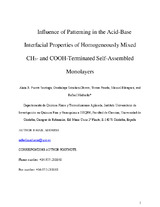Mostrar el registro sencillo del ítem
Influence of Patterning in the Acid–Base Interfacial Properties of Homogeneously Mixed CH3- and COOH-Terminated Self-Assembled Monolayers
| dc.contributor.author | Puente-Santiago, A.R. | |
| dc.contributor.author | Sánchez-Obrero, Guadalupe | |
| dc.contributor.author | Pineda, Teresa | |
| dc.contributor.author | Blázquez, Manuel | |
| dc.contributor.author | Madueño, Rafael | |
| dc.date.accessioned | 2024-02-12T10:16:13Z | |
| dc.date.available | 2024-02-12T10:16:13Z | |
| dc.date.issued | 2018 | |
| dc.identifier.uri | http://hdl.handle.net/10396/27420 | |
| dc.description.abstract | The acid/base interfacial behavior of mixed self-assembled monolayers (SAMs) of 1-decanethiol (DT) and 11-mercaptoundecanoic acid (MUA) formed on gold from a micellar medium has been characterized by electrochemical impedance spectroscopy (EIS) and infrared reflection-absorption spectroscopy (IRRAS) titration experiments as a function of their surface composition. The surface composition is determined from the interfacial capacitance of the SAMs that behave as a dielectric medium of the expected thickness for well-organized layers. The interaction parameter and the apparent and the intrinsic surface pKa values of these pH-responsive SAMs are obtained by fitting the EIS and IR titration curves to the 1-pK model. The shift in the surface pKa while decreasing the MUA surface fraction resembles the behavior of homogeneously mixed systems. The trends observed can be explained by the lowering of intermolecular in-plane repulsive interactions between neighboring MUA molecules and by the local solvation and hydrophobic effects when the MUA domains decrease below a critical size and the terminal groups are probably titrated at domain boundaries, small arrangements, or even isolated. The transition between both scenarios and the formation of hydrogen bonding interactions upon a structural reorganization are conditioned by the heterogeneity in the size distribution of MUA and DT molecular domains which depends on the formation conditions of the SAMs. All together it is demonstrated to play a role in the acid/base properties of these monolayers which has a direct implication in the proper design of interfacial devices based on organic molecular junctions or biomolecular assemblies. | es_ES |
| dc.format.mimetype | application/pdf | es_ES |
| dc.language.iso | eng | es_ES |
| dc.publisher | American Chemical Society | es_ES |
| dc.rights | https://creativecommons.org/licenses/by-nc-nd/4.0/ | es_ES |
| dc.source | Puente-Santiago, A. R., Sánchez-Obrero, G., Pineda, T., Blázquez, M., & Madueño, R. (2018). Influence of Patterning in the Acid–Base Interfacial Properties of Homogeneously Mixed CH3- and COOH-Terminated Self-Assembled Monolayers. The Journal Of Physical Chemistry C, 122(5), 2854-2865. https://doi.org/10.1021/acs.jpcc.7b11878 | es_ES |
| dc.subject | Mixed self assembled monolayers | es_ES |
| dc.subject | 11-mercaptoundecanoic acid | es_ES |
| dc.subject | Electrochemical impedance spectroscopy | es_ES |
| dc.subject | Infrared reflection absorption spectroscopy | es_ES |
| dc.subject | Titration | es_ES |
| dc.subject | Interfacial capacitance | es_ES |
| dc.subject | Structural reorganization | es_ES |
| dc.title | Influence of Patterning in the Acid–Base Interfacial Properties of Homogeneously Mixed CH3- and COOH-Terminated Self-Assembled Monolayers | es_ES |
| dc.type | info:eu-repo/semantics/article | es_ES |
| dc.relation.publisherversion | https://doi.org/10.1021/acs.jpcc.7b11878 | es_ES |
| dc.relation.projectID | Gobierno de España. CTQ2014-60227-R | es_ES |
| dc.relation.projectID | Gobierno de España. CTQ-2015−71955-REDT | es_ES |
| dc.relation.projectID | Junta de Andalucía. P10-FQM-6408 | es_ES |
| dc.rights.accessRights | info:eu-repo/semantics/openAccess | es_ES |

